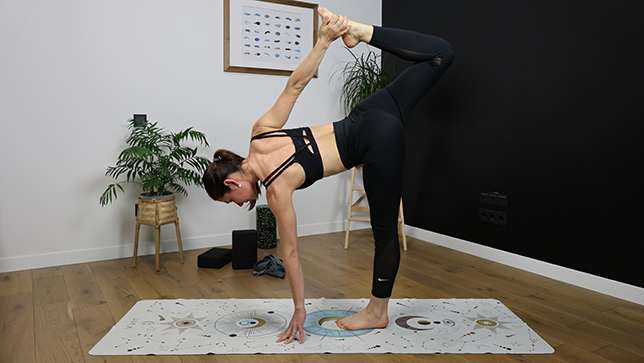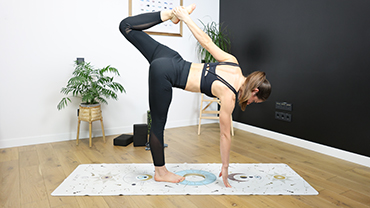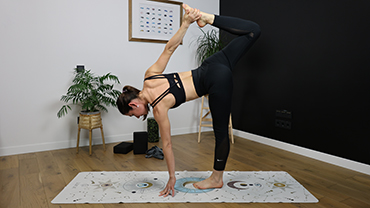Dancer Pose II - Natarajasana II

Contents
Dancer Pose II also known as Natarajasana II, is an intermediate to advanced yoga posture that requires balance, flexibility, and strength. This pose is a variation of the traditional Dancer Pose, and it adds an extra challenge by requiring you to reach your hand to the ground while balancing on one leg.
This pose offers many benefits for the body, including stretching the hips, thighs, and chest while strengthening the legs, ankles, and core. It also improves balance, coordination, and focus, as well as helps to open the heart and stimulate the third eye chakra.
Overall, Dancer Pose with the hand to the ground is a beautiful and challenging posture that can offer many physical, mental, and spiritual benefits. With practice and patience, you can develop the strength, flexibility, and balance needed to master this pose and experience its many rewards.
Pose Detail
- Difficulty: Advanced, Intermediate
- By Type: Balancing Yoga Poses, Chest Opening Yoga Poses, Flexibility Yoga Poses, Hip Opening Yoga Poses, Strengthening Yoga Poses
- Body Position: Forward Bend Yoga Poses, Standing Yoga Poses
Step-by-Step Instructions
Benefits and Contraindications
Strengthens the legs, ankles, and core muscles
Improves balance, coordination, and posture
Stretches the thighs, hips, chest, and shoulders
Stimulates the heart and opens the chest
Helps to release stress, anxiety, and tension
Enhances focus, concentration, and mindfulness
Low blood pressure or dizziness
Knee or ankle injuries or limitations
Recent or chronic back pain
Pregnancy or menstruation
Inability to balance on one leg or hold the pose safely
Any discomfort or pain in the pose
Photo poses in different angles


Modifications and Props for Beginners
- If you have limited flexibility or can’t reach your foot with your hand, you can use a strap or a towel to hold onto your foot. Place the strap around the ball of your foot, and hold onto the ends of the strap with your hand as you lift your leg.
- If you can’t reach the ground with your hand, you can use a block to support your hand. Place the block in front of you, and lower your hand onto the block as you hinge forward from your hips.
Useful Tips
- To help with balance and focus, keep your gaze forward and avoid looking down at the ground or up at the ceiling.
- To help with stability and strength, engage your core muscles by drawing your belly button toward your spine and lifting your pelvic floor.
Frequently Asked Questions
Dancer Pose II or Natarajasana II can be challenging for beginners, as it requires balance, flexibility, and strength. However, with proper modifications and guidance, beginners can safely practice this pose and gradually work up to the full expression.
Some common mistakes to avoid when practicing Dancer Pose II or Natarajasana II include collapsing the chest, lifting the hip of the lifted leg, rounding the lower back, and over-stretching the knee of the standing leg. It’s important to approach the pose with mindfulness, alignment, and proper engagement of the core and leg muscles.
Dancer Pose II or Natarajasana II can be helpful for relieving back pain, as it helps to stretch the back muscles and improve spinal mobility. However, it’s important to approach the pose with caution and to listen to your body’s limitations and needs.
Natarajasana II can be harmful or dangerous if not practiced with proper alignment, awareness, and respect for your body’s limitations. It’s important to approach this pose with patience, humility, and mindfulness, and to listen to your body’s needs and sensations. If you experience any pain or discomfort, it’s best to come out of the pose and seek guidance from a yoga teacher or healthcare provider.
Variations
- Dancer Pose
- Revolved Dancer Pose
- Dancing Shiva Pose
- Flamingo Pose
- One-Legged Mountain Pose
- Dancer Pose With A Strap